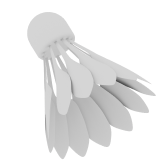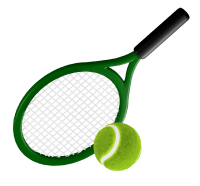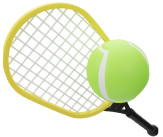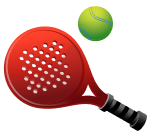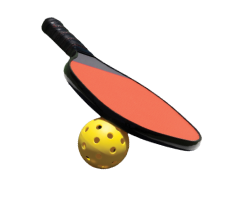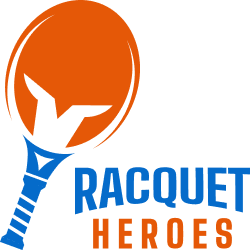Table Tennis
Know all the basic Table Tennis rules and regulations, how to play the
game, court lines, how to score points and more!
1. THE TABLE
-
Size
The playing surface is rectangular, measuring 2.74m long, 1.525m wide, and 76cm above the floor. -
Lines and AreasThe vertical sides of the tabletop are not part of the playing surface.
-
Material
The surface can be made of any material, providing a uniform bounce of about 23cm when a ball is dropped from 30cm.
-
Color
The surface must be uniformly dark and matt with white lines along the edges: 2cm on the sides and ends. -
Net
The surface is divided into two equal courts by a net running parallel to the end lines. -
Doubles Court
Each side is divided into two half-courts by a 3mm white center line, which is part of the right half-court.
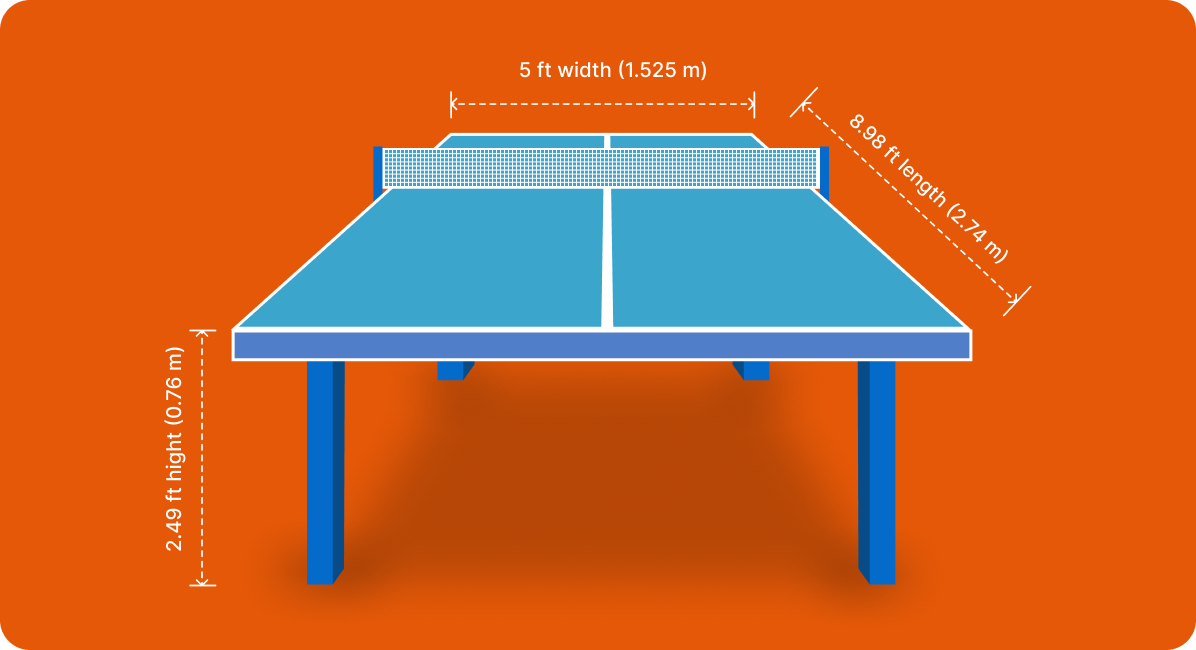
2. THE NET ASSEMBLY
-
Components
The net assembly includes the net, suspension, supporting posts, and the clamps attaching them to the table -
Post Height
The net is suspended by a cord attached to two upright posts, each 15.25cm high. The posts are positioned 15.25cm outside the sidelines. -
Net Height
The top of the net must be 15.25cm above the playing surface along its entire length. -
Net Positioning
The bottom of the net should be as close to the playing surface as possible, with the ends attached securely to the posts from top to bottom.
3. THE BALL
-
Shape and Size
The ball must be spherical with a diameter of 40mm. -
Weight
The ball shall weigh 2.7g. -
Material and Color
The ball is made of plastic and must be either white or orange, with a matt finish.

4. THE RACKET
-
Shape and Size:
The racket can be any size, shape, or weight, but the blade must be flat and rigid. -
Blade Composition:
The blade must be at least 85% natural wood. Fibrous materials can’t exceed 7.5% of the thickness or 0.35mm. -
Surface Covering:
-
Ordinary pimpled rubber:Pimples facing outwards, maximum thickness (including adhesive) of 2.0mm.
-
Sandwich rubber:Pimples facing inwards or outwards, total thickness (including adhesive) up to 4.0mm.
-
Pimpled rubber density:Pimples facing inwards or outwards, total thickness (including adhesive) up to 4.0mm.
-
Even Thickness:
All layers of the blade, covering material, and adhesive must be continuous and evenly thick
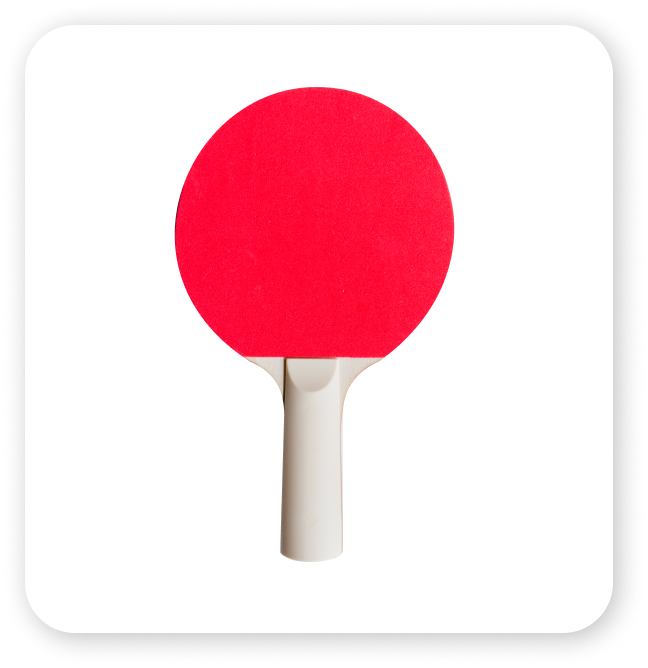
-
Covering Limits:
The covering material should extend to the blade’s edge but not beyond, except for the part near the handle that may be uncovered or covered with any material. -
Surface Color:
One side of the racket must be matt black, and the other a bright color distinguishable from black and the ball. -
No Treatment:
The racket covering must not undergo any physical or chemical treatment. -
Pre-Match Inspection:
Players must show and allow the opponent and umpire to inspect their racket before the match or when switching rackets during the game.
5. DEFINITIONS
-
Rally
The period when the ball is in play. -
Ball in Play
From the moment the ball is stationary on the server’s hand until the rally is decided as a let or a point. -
Let
A rally with no result scored. -
Point
A rally with a result scored.
-
Racket Hand
The hand holding the racket. -
Free Hand/Arm
The hand not holding the racket and its corresponding arm. -
Striking the Ball
Touching the ball with the racket or racket hand below the wrist during play. -
Obstructing the Ball
Touching the ball when it is above or moving towards the playing surface without having touched the player’s court.
-
Server
The player who strikes the ball first in a rally.. -
Receiver
The player who strikes the ball second in a rally. -
Umpire
The person in charge of controlling the match.
-
Assistant Umpire
The person assisting the umpire with certain decisions. -
Player’s Items
Anything the player is wearing or carrying at the start of the rally, excluding the ball. -
End Line
Considered to extend indefinitely in both directions.
6. SERVICE RULES
-
Starting PositionThe ball must rest freely on the open palm of the server’s stationary free hand.
-
Ball ProjectionThe server must toss the ball vertically upwards at least 16cm without spinning it and let it fall before striking it.
-
First ContactThe ball must first touch the server’s court, then the receiver’s court; in doubles, it must land in the right half of both courts.
-
Ball VisibilityThe ball must remain visible above the playing surface and behind the server’s end line. It cannot be hidden by the server, their partner, or anything they wear.
-
Free Arm PositionOnce the ball is tossed, the server’s free arm and hand must be removed from the space between the ball and the net.

-
Service Legality
The player must serve so the umpire or assistant umpire can verify its legality. If the service is questionable, the umpire may issue a warning for the first offense. -
Physical Disabilities
The umpire may relax service rules if a player’s physical disability prevents compliance.
7. THE RETURN
-
Returning the Ball
After being served or returned, the ball must be struck so it touches the opponent’s court, either directly or after hitting the net assembly.

8. THE ORDER OF PLAY
-
Singles
The server makes the first serve, the receiver returns, and then both alternate returns. -
Doubles
The server serves, the receiver returns, then the server’s partner returns, followed by the receiver’s partner, and players continue alternating in this sequence. -
Doubles with a Wheelchair Player
After the server and receiver play their turn, either player from the disabled pair can make subsequent returns.
9. A LET
9.1 A rally is a let if
- The ball touches the net assembly during service but the service is otherwise correct or the receiver/partner obstructs the ball.
- The receiver or pair is not ready for the service, and they do not attempt to strike the ball.
- Failure to serve or return is due to a disturbance outside the player’s control.
- The umpire or assistant umpire interrupts play.
- In wheelchair play, if the ball:
-
Returns towards the net after touching the receiver’s court.
-
Comes to rest on the receiver’s court.
-
In singles, leaves the receiver’s court after touching the sideline.
9.2 Play can be interrupted
- To correct an error in serving, receiving, or ends.
- To introduce the expedite system.
- To warn or penalize a player or adviser.
- If playing conditions are disturbed and affect the rally outcome.
10. A POINT
10.1 A player scores a point if:
- The opponent fails to make a correct service.
- The opponent fails to make a correct return.
- After a service or return, the ball touches anything other than the net assembly before being struck.
- The ball passes over or beyond the end line without touching the opponent’s court.
- The ball passes through the net, net post, or between the net and the playing surface.
- The opponent obstructs the ball.
- The opponent deliberately strikes the ball more than once in succession.
- The opponent uses a racket blade surface that doesn’t meet requirements.
- The opponent or anything they wear or carry moves the playing surface.
- The opponent or anything they wear or carry touches the net assembly.
- The opponent’s free hand touches the playing surface.
- A doubles opponent strikes the ball out of sequence.
- Points are scored under the expedite system.

10.2 In wheelchair play
- The opponent does not maintain minimum contact with the seat or cushion.
- The opponent touches the table with a hand before striking the ball.
- The opponent’s footrest or foot touches the floor during play.
10.3 In doubles with at least one player in a wheelchair, any part of the wheelchair or a standing player’s foot crosses the imaginary center line.
11. A GAME
- A game shall be won by the player or pair first scoring 11 points unless both players or pairs score 10 points, when the game shall be won by the first player or pair subsequently gaining a lead of 2 points.
12. A MATCH
- A match shall consist of the best of any odd number of games
13. THE ORDER OF SERVING, RECEIVING AND ENDS
13.1 Choosing the Order
- The initial choice of serving, receiving, or ends is decided by lot.
- The winner of the lot can choose to serve, receive, or start at a particular end
13.2 Alternating Choices
- The other player or pair will take the remaining choice (serve/receive or end).
13.3 Service and Receiving Sequence
- Players switch serving and receiving every 2 points.
- If both players or pairs reach 10 points, or if the expedite system is in use, players serve for 1 point each in turn.
13.4 Doubles Matches
- The pair serving first in a game decides who will serve.
- The receiving pair decides who will receive first.
- In subsequent games, the first server’s previous receiver will receive first.

13.5 Service Changes in Doubles
- At each change of service, the previous receiver becomes the new server, and the previous server’s partner becomes the new receiver.
13.6 End Changes
- The pair or player serving first in a game will receive first in the next game.
- In the last possible game of a doubles match, the order of receiving changes when a pair scores 5 points.
- Players or pairs change ends when one scores 5 points in the last possible game.
14. OUT OF ORDER OF SERVING, RECEIVING OR ENDS
14.1 Wrong Server or Receiver
- If a player serves or receives out of turn, the umpire will stop play when the error is discovered.
- Play resumes with the correct server and receiver according to the original order and score, based on the established sequence.
14.2 Wrong Ends
- Players haven’t changed ends when they should have, the umpire will stop play when the error is discovered.
- Play resumes with players at the correct ends according to the original sequence and score.
14.3 Points Scored
- All points scored before the error is discovered are counted.

15. THE EXPEDITE SYSTEM
15.1 When It Applies
- The expedite system starts after 10 minutes of play or if both players or pairs request it.
- It will not be used if at least 18 points have been scored.
15.2 Starting the Expedite System
- If the system is due to start while the ball is in play, the umpire will stop play. It resumes with the server from the interrupted rally.
- If the ball is not in play, it resumes with the server from the previous rally.
15.3 Serving and Scoring
- Players serve for 1 point each in turn.
- If the receiving player or pair makes 13 correct returns in a rally, the receiver scores a point.
15.4 Order and Duration
- The expedite system does not change the order of serving and receiving.
- Once introduced, it remains in effect until the end of the match.
All rules are referenced from ITTF Statutes 2024, provided by The International Table Tennis Federation.



